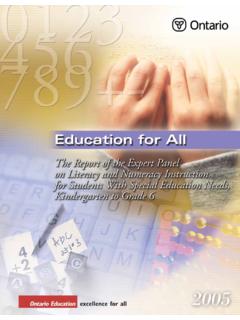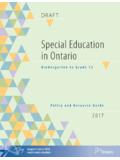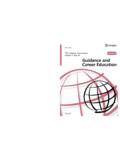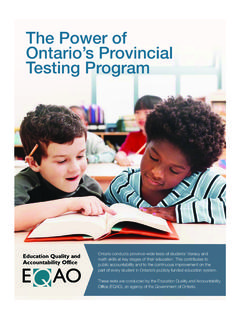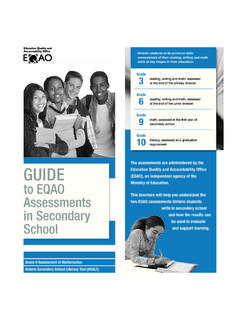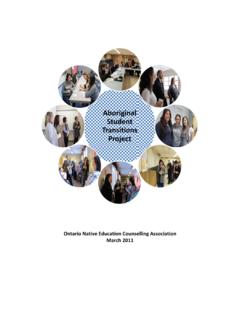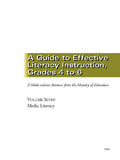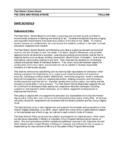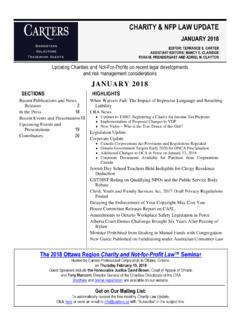Transcription of Transition Planning: A Resource Guide - OAFCCD
1 Ministry of Education2002 Transition Planning: A Resource GuideIntroduction ..3 Regulatory and Policy Requirements ..4 The School Board s Role ..6 Supporting and Coordinating the Transition - planning Process ..6 Developing a Board Transition - planning Policy ..6 Providing In-Service Orientation ..7 Establishing and Maintaining Links With Other Organizations ..7 Establishing a Transition - planning Advisory Committee ..7 The Principal s Role ..8 Developing School-Level Procedures ..8 Creating a Transition - planning Resource Group ..9 Providing Orientation Sessions for Transition - planning Teams ..9 Monitoring Implementation ..10 The Transition - planning Team ..11 Roles and Responsibilities of Team Members.
2 11 The Student, Family Members, and the Student s Support Network ..11 School System Personnel ..12 Other Participants ..14 The Transition - planning Process for Individual Students ..17 Phase 1: Preparation ..17 Appointing the Transition - planning Team Leader ..17 Selecting the Transition - planning Team ..17 Orienting the Team Members ..18 Collecting Background Documentation on the Student ..18 Designing the Process ..18 Arranging a Meeting ..19 Phase 2: Development of the Plan ..19 Identifying the Student s Transition Goals ..22 Identifying the Steps and Actions Necessary for Achieving the Goals ..23 Coordinating the Transition Plan With the IEP and Other Plans ..27 ContentsUne publication quivalente est disponible en fran ais sous letitre suivant : Guide sur la planification de la Transition , publication is available on the Ministry of education swebsite at : A RESOURCEGUIDEI dentifying Responsibilities and Timelines.
3 27 Resolving Disputes ..27 Phase 3: Documentation and Implementation ..27 Recording the Plan ..27 Filing and Distributing Copies of the Plan ..27An Integrated planning Process ..29 The IPRC Statement of Decision ..29 The Individual education Plan (IEP) ..29 The Annual education Plan (AEP) ..30 The Cooperative education Personalized Placement Learning Plan ..30 Exit Programs ..30 The MCFCS Individual Support Agreement ..31 Health Care and Psychosocial Support Documents ..31 Appendices1. Sample Transition Plans ..322. Sample Forms Related to Transition planning ..403. Local Offices of the Ministry of education , the Ministry of Community, Family and Children s Services, and the Ministry of Health and Long-Term Care.
4 42 Selected Resources ..43 Acknowledgements ..46 List of Figures1. Designing the Process and the Plan Some Guiding Principles ..202. Sample Checklist for the Components of a Transition Plan ..213. Self-Advocacy and Disclosure ..224. Sample Actions for Different Stages Prior to Transition ..245. Transition -Related Learning Expectations ..263 The Transition from school to work, further education ,1and community living can be particularly challeng-ing for some exceptional students. The probability ofa successful Transition is significantly increased whenschools work with parents,2employers, communityagencies, and providers of further education to developcoordinated Transition plans for exceptional principals are required to ensure that a transi-tion plan is prepared, as part of the Individual Educa-tion Plan, for each exceptional student who is 14 yearsof age or older, unless the student is identified asexceptional solely on the basis of giftedness.
5 Theserequirements are set out in Ontario Regulation 181/98and are elaborated in the Ministry of education s pol-icy document Individual education Plans: Standards forDevelopment, Program planning , and Implementation, Guide presents a range of suggestions from whicheducators may select ideas that would be useful intheir particular local context. It is not expected thatevery suggestion outlined here will be appropriate toor incorporated in every school board s3or school stransition- planning Guide sets out no new policy requirements; rather,it provides detailed examples of steps for implement-ing the policy, in order to assist all those involved inthe Transition - planning process. Those involved inthe process include: school board officials, principals, teachers, andothers involved in planning and providing specialeducation programs and services; students and their families.
6 And health care workers, community workers, and others who support students before and after theyleave who may benefit from this Guide includeschool board officials who are involved in planningfor other student transitions, such as entry intoschool or Transition from one school to Transition plan as described in this document is theschool s written plan to assist the student in making asuccessful Transition from school to work, further educa-tion, and community the student and his or her family and personalsupport network, the Transition plan: identifies goals for work, further education , andcommunity living that: reflect actual opportunities and resources thatare likely to be available after the student leavesschool; are achievable by the student, given appropriatesupports; defines the actions that are necessary year by yearto help the student achieve his or her goals; and clarifies the roles and responsibilities of the student,family, and others in carrying out these turning to details of definitions, regulations,and suggestions concerning roles and process, readersmay find it helpful to glance at the four sample tran-sition plans included in Appendix 1.
7 These sampleplans illustrate a range of approaches that may betaken to respond to the varied needs of The termfurther educationis used to refer to continuing study(after the student leaves school) in any formal program, including: a program at a college of applied arts and technology; a university program; a private vocational school program; an apprenticeship program; a school board continuing education program; a government-funded educational or training program such asa literacy or life-skills Throughout this document, parentsis used to refer to both parent(s) and guardian(s).3. The terms school boardand boardare used in this document torefer to district school boards and school following paragraphs summarize the requirementsoutlined in Regulation 181/98 (as amended by Regu-lation 137/01) that apply to Transition planning .
8 Therelevant sections of the regulation are identified inparentheses. For the reader s convenience, excerptsfrom Regulation 181/98 are provided on page exceptional students who are age 14 or over andwho are not identified solely as gifted (subsections 6[5]and 7[5]), the student s Individual education Plan(IEP) must include a Transition plan (subsections 6[4]and 7[4]) for the student s Transition from school towork, further education , and/or community living(subsection 6[4]).The principal is responsible for ensuring that the IEP,including the Transition plan:1. is developed in consultation with the parent (and the student, if he or she is age 16 or over)(clause 6[6][a]);2. is developed in consultation with communityagencies and postsecondary institutions, as judgedappropriate by the principal (subsections 6[7] and7[6]);3.
9 Takes into consideration any recommendationsconcerning the student s special education programor services made by an Identification, Placementand Review Committee (IPRC) or Special EducationTribunal (clause 6[6][b]);4. is completed or revised as required, and a copysent to the parent (and to the student, if age 16 or over) within 30 school days of: placement of the student in a program (subsection 6[8]); a change of placement (subsection 7[7]); a confirmation of the continuation of an exist-ing placement in an IPRC review decision, or aschool board decision upon receipt of recom-mendations from an appeal board, or a SpecialEducation Tribunal decision (subsection 7[7]);5. is stored in the student s Ontario Student Record(OSR) file, unless the student s parent objects inwriting (section 8).
10 The regulation also stipulates that a committee con-ducting a review of the identification or placement ofa student must, with the written permission of thestudent s parent, consider the student s progress withreference to his or her IEP, including the transitionplan (subsection 23 [2]).Standards for Transition plans are outlined in theMinistry of education s policy document IndividualEducation Plans: Standards for Development, ProgramPlanning, and Implementation, 2000. As stated there,every Transition plan must include the following elements: specific goals for the student s Transition to post-secondary activities. The goals must be realisticand must reflect the strengths, needs, and interestsof the student; the actions required, now and in the future, toachieve the stated goals.
